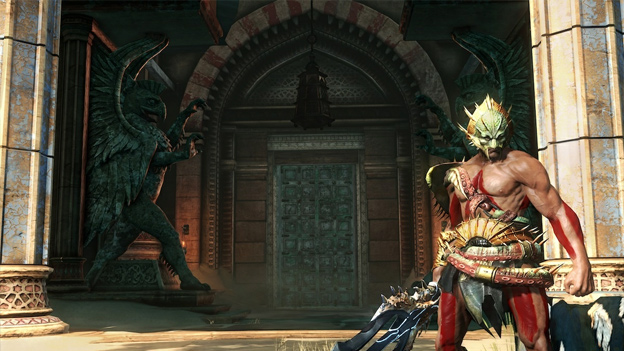Rage Out With Your Friends
God of War III provided a fairly definitive capstone to the PlayStation-original trilogy. Even if Kratos, long-running protagonist and antihero of the franchise, managed to survive the events at the end of the game (there’s reason to debate that), the entire landscape of the series would have been forever changed. Extinguishing an entire pantheon of gods, and a sizable chunk of their most notable offspring, tends to have that sort of effect.
Yet here we stand, on the precipice of another release in the series. It’s probably little surprise, given the story thus far, that this latest entry will be stretching back into the series’ past, ever closer to Kratos’ genesis. That’s simply a matter of logistics. The specific time chosen, though—years prior to the original game—is supposed to present us with a more human, less embittered Kratos than in any other game in the series.

Oh, he’s certainly angry, and already embroiled in his quest for vengeance against Ares, who had a part in the Spartan slaying his own family, but this is supposed to be a Kratos who isn’t entirely consumed by that drive, who seeks a way to free himself from servitude that circumvents a direct confrontation. So it is that he seeks out the Furies, three sister-deities in Greek mythology (though it’s worth noting that “Furies” is the Roman name, while in Greek they would be the “Erinyes”) who embody vengeance. An appropriate target for a man seeking redemption, gradually sinking into a pit of vengeful rage.
And though this is a more human Kratos we’re facing, his brutality is all the greater. While combat has always been the bailiwick of God of War titles, and brutality a hallmark of the franchise, Ascension looks to take that to new heights. Kratos’ attacks can now target individual parts of certain enemies, dealing locational damage and providing new options in combat, introducing new ways in which to dismember, decapitate, and disembowel his foes.
This includes a reconfiguration of the brutal finishing moves that have been a cornerstone of the series since day one. Whereas in past games Kratos would, upon dealing sufficient damage to a foe, be prompted with a series of quick-time button presses that, upon his success, would result in the systematic destruction of his foe in bombastically violent fashion, the goal in Ascension is to make the process somewhat more freeform. Rather than always being prompted with specific button sequences, players will be expected to react to their enemy’s attacks and rip the foe apart in real time. In a game in which combat is already all about fluidity, alterations that better serve that sense of flow are almost assuredly a boon. Additionally, Ascension will allow Kratos to pick up temporary weapons, as well as disarm foes, and continue their combos with these new armaments.
On the puzzle side of things, since the God of War series does tend to supplement its gory action with a degree of brain-twisting, Ascension introduces the Life Cycle. This mechanic will enable Kratos, in all of his grimacing glory, to alter the flow of time. As you might imagine, this has a tremendous effect on the types of puzzles on display, introducing a new dimension to the game’s mental gymnastics.

And that’s just single-player. Ascension also introduces the series’ first multiplayer mode, consisting of online battles in the styles of the main game’s combat. This is the big new feature for Ascension, the thing that has been cited as Sony potentially “testing the water” for multiplayer in a future God of War game, one that would serve as a direct sequel to God of War III. That’s all speculation, though.
Sticking to the facts, the multiplayer is divided as follows: You create your brusque, manly hero and assign him to one of five gods. As of now, Ares, Zeus, Poseidon, and Hades have been revealed, with a fifth as of yet undeclared. Your choice goes beyond mere flavor text. Which god you choose to pledge fealty to determines what abilities you’ll receive and what sorts of bonuses you’ll get in combat. Zeus, for example, enhances one’s defense and magic capabilities. Ares, in contrast, serves as the more familiar melee brawler type.

Following a brief combat tutorial, the player is plunked into a game, which fits one of four types: Favor of the Gods, Favor of the Gods (Team), Capture the Flag, and one that has yet to be revealed. The basic Favor of the Gods is a four-player free-for-all deathmatch, with environmental attacks and random intervention from the gods affecting the proceedings. Meanwhile, the team version of Favor of the Gods pits two teams of four, one representing Sparta while the other stands for Troy, do battle for various control points as they scramble to overpower their opponents and raise their victory point total (deemed Favor) to the cap.
Maps are based on notable locations from the series and can include not only power-ups and traps, but stage specific hazards/goals. In the Desert of Lost Souls, a titanic cyclops named Polyphemus provides a constant, overbearing threat to the players. If one team should become dominant, though, they’ll be graced with the Spear of Olympus, which allows them to dispatch Polyphemus. These sorts of light story elements are slated to be integrated into the multiplayer; it’s supposed to be a bit more than just fighting, leveling, and repeating ad nauseum.

It’s perhaps a bit monotonous that we’re still experiencing Kratos, already a fairly one-note character, during his angry stage. There’s only so much constant, unabated scowling and bellowing that one can take before it’s all just drowned out by mental white noise. That said, God of War: Ascension’s single-player definitely looks to make worthwhile changes to the gameplay and, while its campaign is stated to be a bit on the shorter side, the multiplayer seems poised to make up the difference and then some.
Game Features:
